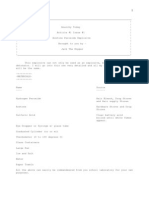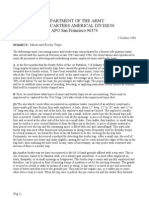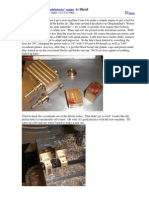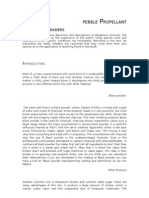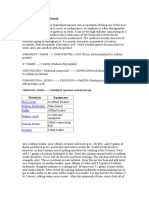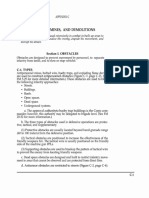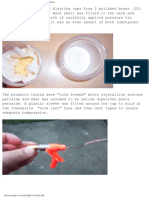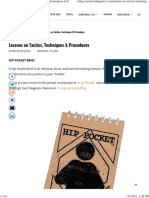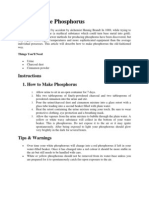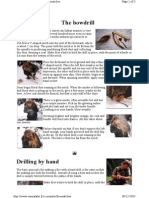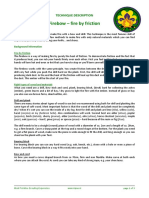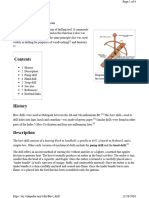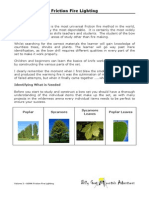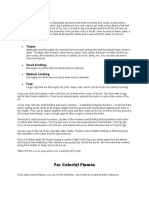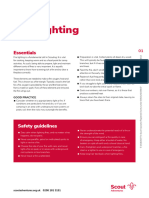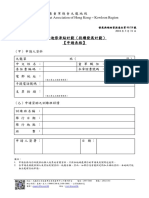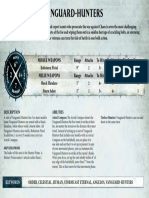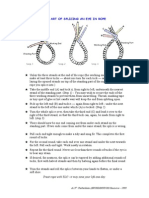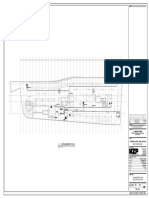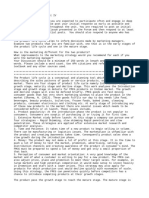How a Boy Scout makes fire
without matches
This article is from the 1919 book, Everyday Science with
Projects by William H. Snyder (which is why it starts with
Figure 5). If you attempt this project to start a camp fire, use
the appropriate precautions that you would use with any fire,
and make certain that you are in an approved area for camp
fires.
"Five things are necessary to produce a rubbing-stick fire: a
drill or spindle, a fire-block or hearth, a hand-socket, a bow,
and tinder.
In choosing wood for making the drill and fire-block, great
care must be exercised. The wood should be dry and long-
seasoned, but sound. Gummy and resinous woods should be
avoided. A test for good wood for this purpose is that the
wood-dust ground off shall be smooth to the touch, not gritty
or sticky. Two of the best and most widely distributed woods
are cottonwood and willow. Better even than these are the
cedar, the cypress, or the tamarack, if they can be had. If
none of these is at hand, try soft maple, elm, poplar,
sycamore, or buckeye.
Drill. - Out of a straight dry branch or piece of seasoned
wood, whittle a roughly rounded spindle, about 12 inches long,
and not more than 3/4 inch in diameter. Sharpen the two ends
of the stick, as shown in Figure 5.
Fire-block. -Take a piece of wood not more than 12 inches
long, 2 or 3 inches wide, and not more than 3/4 inch thick. On
one side of this board, well toward one end, cut a notch 1/2
inch deep and bevel it slightly toward the under side of the
board. About 1/8 inch, or less, from the tip of the notch make
a little hollow or pit in the board, an shown in Figure 6, A.
Hand-socket. - If nothing better is at hand, take a pine or
hemlock knot that will just fit comfortably into the palm of the
hand. Make a pit in the center of one of the
flat surfaces of the knot, about 1/4 inch in
diameter and 1/4 inch deep.
If you are going to practice fire-making on
Page 1 of 3 How a Boy Scout Makes Fire without Matches
30/12/2003 http://home.houston.rr.com/molerat/firebow.htm
camping trips, you will find it a great saving of time to have a
socket made for your permanent use. Take a solid block of
wood 5 or 6 inches Ion, 1 3/4 inches wide, and 1 inches
thick. Set in the middle of one face of this block a piece of
soapstone or marble 1 inch square and about 3/4 inch deep.
In the center of this piece of stone make a small smooth pit,
3/8 inch wide and 3/8 inch deep. Smooth and round the
opposite face of the block so that it will fit your palm
comfortably and can be grasped firmly. The socket in now
ready for use (Figure 7).
Bow. - For this, any slightly curved rigid branch or stick, 18
to 24 inches long, may be used. Fasten a thong of buckskin,
belt-lacing, or of any pliable leather, about 3/8 inch wide, to
the bow, as shown in Figure 8. The thong should be just long
enough so that when it is given one turn around the drill it will
be stretched taut (Figure 9).
Tinder. - Any dry, finely divided material that readily bursts
into flame from a spark is called tinder. Shredded cedar bark,
a wad of dry grass, crumpled dry leaves, willow catkins,
scraped cedar or spruce wood will serve admirably. Any
observing person will be able to find plenty of good tinder in a
forest.
In addition to this tinder,
which is used to nurse the
glowing spark into flame,
the fire-maker should have
at hand a collection of twigs,
long-stemmed dry grass,
splinters, slivers of dry bark,
etc., to be used as kindling
for the larger fuel that is to
follow.
To Make Fire. -Set the
fire-block on firm ground or
on flat rocks or on any
foundation where the block can be kept from slipping or
joggling. Slip a thin chip under the notch of the hearth.
Turn the thong of the bow once around the drill. If the
thong is of the right length, it will now be taut.
Set one point of the drill into the pit near the point of the
notch of the fire-block, fit the upper end into the hand-socket,
and with your left hand hold the drill perpendicular to the
block. Anchor the fire-block with your left foot, and steady
your left hand by resting your left wrist against your left shin.
This is to enable you to keep the drill steadily in an upright
position (Figure 9).
Now with the right hand draw the bow slowly and steadily
Page 2 of 3 How a Boy Scout Makes Fire without Matches
30/12/2003 http://home.houston.rr.com/molerat/firebow.htm
back and forth the full length of the thong, pressing lightly on
the hand-socket. Keep the bow horizontal, and do not touch
the drill with it as you saw back and forth. The twirling motion
of the drill soon makes it bite into the block, boring out
powdered wood. When it begins to smoke, put a little more
pressure on the socket and drill faster. When the dust comes
out in a compact mass and the smoke increases to a
considerable volume, you probably have the spark.
Carefully lift the fire-block so as to leave the smoking
powder undisturbed on the chip. Gently fan this with your
hand into a bright glow. Then put a wad of tinder gently over
the glowing powder and blow until the tinder bursts into flame.
Follow this with the kindling and your fire is started.
N. B. If you are left-handed, you will probably reverse the
directions for employing the right and left hands."
Top Home
http://home.houston.rr.com/molerat/
1997-2002 Brian Carusella All rights reserved.
Quotes and images not my own remain in the
copyright of the originator or else in the public domain.
Last updated 1/18/00
Page 3 of 3 How a Boy Scout Makes Fire without Matches
30/12/2003 http://home.houston.rr.com/molerat/firebow.htm






